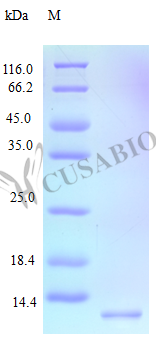The Recombinant Human CXCL9 protein is an indispensable research tool for scientists working in the field of immunology. This C-X-C motif chemokine 9, known by its aliases CXCL9, CMK, MIG, and SCYB9, is expressed in E. coli and spans the 23-125aa region, covering the full length of the mature protein. Supplied as a tag-free, lyophilized powder, this protein can be easily reconstituted with sterile water or an appropriate buffer to suit a wide range of experimental requirements.
Our Recombinant Human CXCL9 protein demonstrates a high purity of over 97%, as established by SDS-PAGE and HPLC analyses. Endotoxin levels are meticulously controlled, ensuring that they remain below 1.0 EU/µg as verified by the LAL method. The protein is fully biologically active, as demonstrated by its efficacy in a chemotaxis bioassay using human peripheral blood T-lymphocytes, with a functional concentration range of 10-100 ng/ml.
Several studies have emphasized the importance of CXCL9 in immunology research. For example, Luster et al. (1988)[1] identified the interferon-γ-induced protein 10, later known as CXCL9, and described its role as a chemoattractant for monocytes and T cells. Moreover, Groom and Luster (2011)[2] highlighted the diverse roles of CXCL9 in regulating immune responses and controlling infections. Most recently, Hirahara et al. (2020)[3] discussed the potential of CXCL9 as a biomarker and therapeutic target in autoimmune diseases. These studies underscore the significance of CXCL9 in the immune system and hint at its possible application in the treatment of immune-related diseases.
References:
1. Luster AD, Unkeless JC, Ravetch JV. γ-Interferon transcriptionally regulates an early-response gene containing homology to platelet proteins. Nature. 1988;334(6179):265-8.
2. Groom JR, Luster AD. CXCR3 in T cell function. Exp Cell Res. 2011;317(5):620-31.
3. Hirahara K, et al. Development of novel immunotherapies targeting type 1 cytokines and CXCR3. Ann Rheum Dis. 2020;79(2):157-8.






